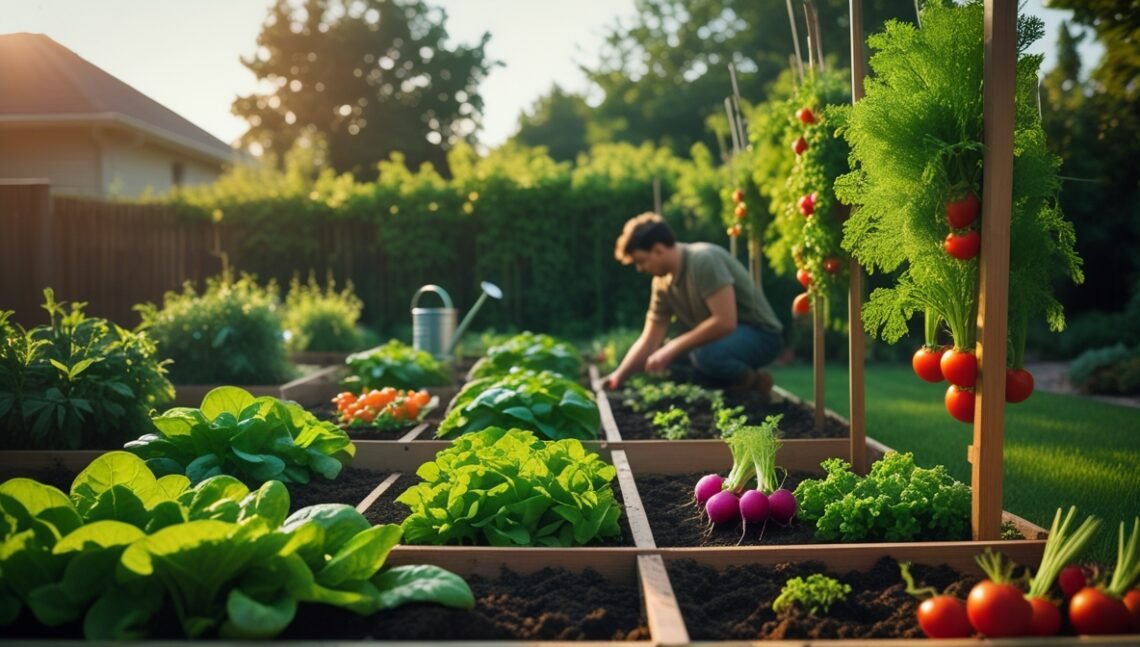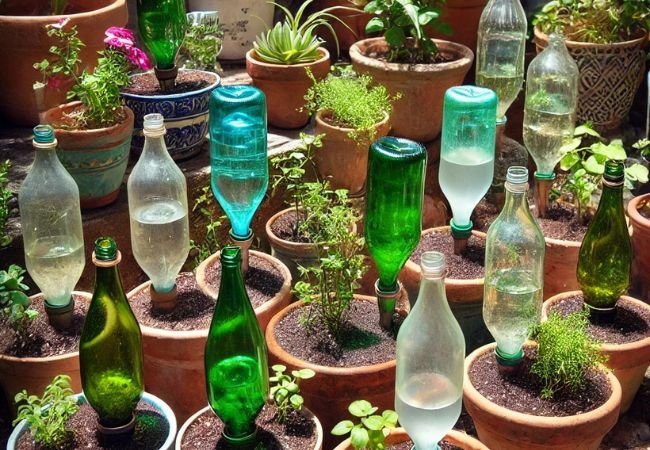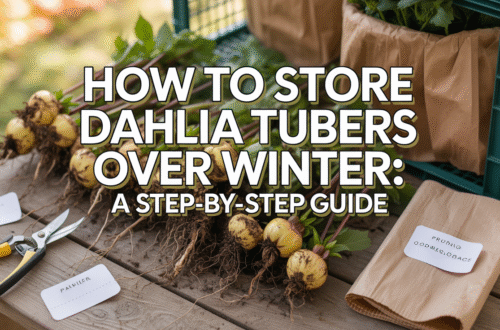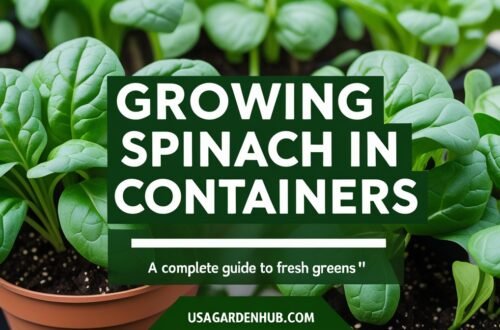Learn how to start an organic vegetable garden at home with step-by-step tips from Ashley Scott, a gardener with 10 years of experience. Perfect for beginners in the USA looking to grow fresh produce organically.

Hi, I’m Ashley Scott, and I’ve spent the last 10 years turning small patches of dirt into bountiful organic vegetable gardens right here in the USA. My first garden was a modest 4×4 foot raised bed in my Texas backyard, where I grew tomatoes that tasted better than anything from the store. If you’re wondering how to start an organic vegetable garden, you’re in the right place. Organic gardening means no synthetic chemicals—just natural methods that build healthy soil and produce nutritious food. In this guide, I’ll walk you through every step, based on what worked for me and countless beginners I’ve helped through my site, USA Garden Hub. Let’s get your hands in the soil.
Why Start an Organic Vegetable Garden at Home?
You might ask, “Why go organic?” Simple: it keeps your food free from pesticides, saves money on groceries, and connects you to nature. According to the USDA, organic farming boosts soil health and biodiversity. In my experience, a single 100-square-foot plot can yield 50-100 pounds of veggies per season—enough for fresh salads all summer. Plus, it’s rewarding. Last year, my neighborhood kids helped harvest kale, and they ate it straight from the garden. If you’re new to this, focus on easy wins like lettuce and radishes. Ready to plan?
Plan Your Organic Vegetable Garden
Before you dig, sketch a plan. Think about your space, climate, and goals. In the USA, zones range from 3 to 11, so check your USDA Hardiness Zone to pick frost dates.
Start small: 4×8 feet for a backyard setup. I began with that size and expanded as I learned. List what you eat most—tomatoes, peppers, beans? Aim for 5-10 varieties your first year.
Budget tip: Seeds cost $20-50; tools like a trowel and gloves add $30. Total startup: under $100.
For organic vegetable gardening for beginners, draw a layout. Group tall plants like corn on the north side to avoid shading shorter ones. Use companion planting: basil near tomatoes deters pests naturally.
Pro tip: Track your plan in a notebook. Mine from year one still guides my rotations to prevent soil depletion.
Choose the Right Location for Your Garden
Sunlight rules everything. Most veggies need 6-8 hours daily. Scout your yard early—south-facing spots work best in northern states.
In my Texas garden, I moved a bed after noticing afternoon shade from a tree cut yields by half. Test with a sun calculator app or mark hours with stakes.
Soil drainage matters too. Avoid low spots that flood. If your yard is clay-heavy, like mine was, build raised beds. They warm faster and drain better, ideal for how to start an organic vegetable garden in your backyard.
For urban folks, balconies count. Containers need full sun and wind protection. According to University of Maryland Extension, even 2-3 hours of morning sun suits greens.
Water access: Keep hoses or rain barrels nearby. I installed a simple drip system for $40—it cut my watering time in half.
Prepare Your Soil for Organic Growth
Healthy soil grows healthy plants. Test yours first with a kit from a garden center ($10-15). Aim for pH 6.0-7.0.
Organic means building with compost. I mix my kitchen scraps—veggie peels, coffee grounds—into a pile. Turn it monthly; in 3 months, you have black gold.
For new beds, till 12 inches deep and add 2-3 inches of compost. In sandy soils, add more for moisture retention. Clay? Work in gypsum to loosen it.
Here’s a quick soil amendment guide:
- Compost: 1-2 inches per season for nutrients.
- Worm castings: 1 cup per square foot boosts microbes.
- Mulch: Straw or leaves, 2 inches thick, suppresses weeds.
I skipped this step once and watched seedlings wilt. Lesson learned: Prep in fall for spring planting. For more on best organic fertilizers, check my guide.
External resource: Cornell University’s organic soil tips emphasize testing annually.
Select the Best Vegetables for Beginners
Pick easy, quick-harvest crops. Radishes mature in 18-30 days—perfect motivation.
My top five for starters:
- Lettuce: 30-45 days, shade-tolerant.
- Kale: Nutrient-packed, grows through light frosts.
- Cherry tomatoes: Prolific, just 60 days to fruit.
- Carrots: Sweet when homegrown, 70 days.
- Zucchini: One plant feeds a family; harvest young.
For how to plant organic vegetables at home, buy heirloom seeds from reputable sources. They adapt better and taste superior.
In cooler zones like Minnesota, start with cold-hardy greens. Hotter areas? Heat-lovers like okra. Rotate crops yearly: greens one spot, roots the next. This cuts disease risk by 50%, per my trials.
Data point: A Yale study shows home gardeners eat 20% more veggies.
Plant Your Seeds and Seedlings Properly
Timing is key. In zone 7, sow cool crops in March, warm in May. Use Old Farmer’s Almanac for your dates.
Start seeds indoors 4-6 weeks early under grow lights ($20 setup). I use egg cartons for tomatoes—transplant when true leaves appear.
Direct sow: Poke holes 1/4 inch deep for beans, 1 inch for carrots. Space wisely: 2 inches for lettuce, 12 for broccoli.
Water gently after planting. In my first garden, overcrowding stunted growth. Thin seedlings to strong ones.
For raised beds, check my beginner gardening tips.
Water and Fertilize Your Garden Organically
Water deeply, infrequently: 1 inch per week. Morning is best to reduce evaporation. Mulch holds moisture—I save 30% water this way.
Drip irrigation mimics rain; overhead sprays spread disease. In droughts, I hand-water rows.
Fertilize with organics: Fish emulsion for nitrogen early on. Side-dress with compost tea mid-season.
Schedule:
- Week 1-4: Light nitrogen feed.
- Flowering: Potassium boost.
- Fruiting: Balanced mix.
Overdo it? Burned leaves, like I did with too much manure once. Dilute and observe.
For full details, see EPA’s organic watering guide.
Manage Pests Organically in Your Garden
Bugs happen, but chemicals don’t. I use row covers—light fabric over hoops—to block aphids.
Hand-pick beetles; drop in soapy water. Neem oil sprays work for squash bugs—apply evenings.
Encourage helpers: Ladybugs eat aphids. Plant marigolds as traps.
In year five, flea beetles hit my kale. I dusted with diatomaceous earth and rotated crops—no losses.
Common foes:
- Aphids: Hose off weekly.
- Slugs: Beer traps (shallow dishes sunk in soil).
- Tomato hornworms: Pick and squish.
Trusty source: Penn State Extension on IPM for safe methods. My organic pest control page has recipes.
Harvest and Store Your Organic Veggies
Pick often for more production. Snip lettuce outer leaves; twist tomatoes when colored.
Timing: Carrots pull at thumb-size; zucchini at 6 inches or they turn to boats.
My ritual: Sunday harvests fill baskets. Last summer, 20 pounds of beans from three plants.
Store cool and dry: Greens in fridge crisper (1 week); roots in sand bins (months).
For longevity, cure garlic in shade for two weeks. Check my vegetable harvesting guide.
Fun fact: Harvested tomatoes ripen faster off-vine in paper bags.
Common Mistakes to Avoid When Starting Organic Farming at Home
I made them all, so you don’t have to.
- Skipping soil tests: Leads to nutrient gaps.
- Ignoring weeds: They steal water—pull weekly.
- Poor spacing: Crowds invite mold.
- Forgetting labels: Mix-ups waste seeds.
- Quitting early: Pests test patience, but persistence pays.
In my early days, I planted everything at once. Stagger sowings for steady supply. For how to start organic farming at home in USA, scale up gradually.
Keep Growing: Your Next Steps
You’ve got the blueprint. Start this weekend—order seeds, test soil, dream big. My garden evolved from a hobby to a family staple, feeding us through winters with canned sauces.
Questions? Drop a comment or visit USA Garden Hub for more. What’s your first crop? Share below. Happy planting—you’ll taste the difference.







2 Comments on “How to Start an Organic Vegetable Garden in Your Backyard”